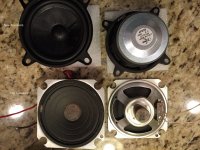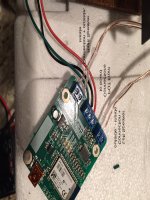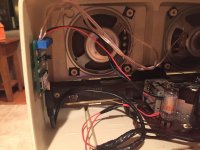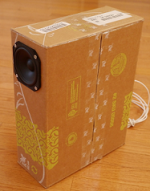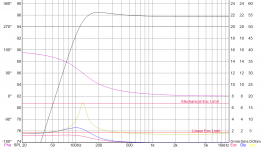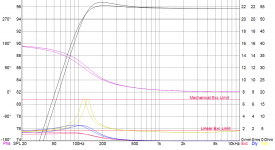Hi there gurus,
I ran into a bump last week on a DIY radio project. I have a 6w (2x3w) amp powered via USB that I tried replacing the 4inch speakers at 4OHMs that I had. Speakers are currently 3Watts are and I guess they fit the bill with the AMP I have as they sound decent when playing 50s music. So it's pretty nostalgic.
On the other hand, I wanted to upgrade the sound and replace them with the below speakers. Unfortunately, the volume was extremely low. I'd like to figure out what went wrong so that I know when for future reference; Below are the speakers I tried to use before I decided to go back to the old speakers.
FaitalPRO 4FE35 4" Professional Full-Range Woofer 4 Ohm
I ran into a bump last week on a DIY radio project. I have a 6w (2x3w) amp powered via USB that I tried replacing the 4inch speakers at 4OHMs that I had. Speakers are currently 3Watts are and I guess they fit the bill with the AMP I have as they sound decent when playing 50s music. So it's pretty nostalgic.
On the other hand, I wanted to upgrade the sound and replace them with the below speakers. Unfortunately, the volume was extremely low. I'd like to figure out what went wrong so that I know when for future reference; Below are the speakers I tried to use before I decided to go back to the old speakers.
FaitalPRO 4FE35 4" Professional Full-Range Woofer 4 Ohm
Hi,
If the volume is very low the old speakers are
much more sensitive than the new drivers.
Most likely the old drivers are higher Fs and
higher Qts giving a big bump around Fs, that
partly compensates for the cabinets baffle step.
Also possible the amp includes driver EQ.
Your new drivers probably go lower and don't
have the Qts bump. With more juice available
and possibly some EQ they could probably
sound better, they are not bad drivers.
rgds, sreten.
If the volume is very low the old speakers are
much more sensitive than the new drivers.
Most likely the old drivers are higher Fs and
higher Qts giving a big bump around Fs, that
partly compensates for the cabinets baffle step.
Also possible the amp includes driver EQ.
Your new drivers probably go lower and don't
have the Qts bump. With more juice available
and possibly some EQ they could probably
sound better, they are not bad drivers.
rgds, sreten.
Hi,
If the volume is very low the old speakers are
much more sensitive than the new drivers.
Most likely the old drivers are higher Fs and
higher Qts giving a big bump around Fs, that
partly compensates for the cabinets baffle step.
Also possible the amp includes driver EQ.
Your new drivers probably go lower and don't
have the Qts bump. With more juice available
and possibly some EQ they could probably
sound better, they are not bad drivers.
rgds, sreten.
That's super interesting. Can't believe the drivers from 1952 can handle audio better than these expensive 2014 speakers. My amp is 6w so you're probably right on the "juice" portion. The mystery to me now is at what wattage am will the new speakers pump.
Heres a picture of both speakers. Top are the new ones and bottom are the old ones.
Top specs are:
Nominal Diameter4"Power Handling (RMS)30 Watts
Power Handling (max)60 WattsImpedance4 ohms
Frequency Response90 to 20,000 HzSensitivity91 dB 1W/1m
Voice Coil Diameter0.75"
THIELE-SMALL PARAMETERS
Resonant Frequency (Fs)100 HzDC Resistance (Re)3.3 ohms
Voice Coil Inductance (Le)0.04 mHMechanical Q (Qms)3.94
Electromagnetic Q (Qes)0.9Total Q (Qts)0.73
Compliance Equivalent Volume (Vas)0.07 ft.
Bottom speakers all I can find is that they are 4 inches made by RCA and are 3-4 OHMs.
Top specs are:
Nominal Diameter4"Power Handling (RMS)30 Watts
Power Handling (max)60 WattsImpedance4 ohms
Frequency Response90 to 20,000 HzSensitivity91 dB 1W/1m
Voice Coil Diameter0.75"
THIELE-SMALL PARAMETERS
Resonant Frequency (Fs)100 HzDC Resistance (Re)3.3 ohms
Voice Coil Inductance (Le)0.04 mHMechanical Q (Qms)3.94
Electromagnetic Q (Qes)0.9Total Q (Qts)0.73
Compliance Equivalent Volume (Vas)0.07 ft.
Bottom speakers all I can find is that they are 4 inches made by RCA and are 3-4 OHMs.
Attachments
Very fine picture javi, is it possible also fotos of place where they live under opertion and the amp itself.
Of course, here you go.
Attachments
Hi javy thanks pictures, via the web checked data your amp and seems no EQ build in so possibility of error this area non existence, mayby the old drivers sensitivity is in >95dB area where 4FE35 is 91dB.
Could i suggest a quick way to test 4FE35 on another baffle to see if SPL and sound quality increase.
Make a cheap sealed 2-4 liters cardboard box and fill in some cheap stuffing. As inspiration i attach a copied picture of a cardboard box made by xrk971 (Foto copyed from this thread http://www.diyaudio.com/forums/full-range/231951-accidental-mltl-technique.html#post3408616). The other picture is simulation 4FE35 in sealed box at 4 liter Qtc 0,903.
EDIT: If such test turn out a good result soundwise, you could make same cheap arrangement by cardboard inside the radio.
Could i suggest a quick way to test 4FE35 on another baffle to see if SPL and sound quality increase.
Make a cheap sealed 2-4 liters cardboard box and fill in some cheap stuffing. As inspiration i attach a copied picture of a cardboard box made by xrk971 (Foto copyed from this thread http://www.diyaudio.com/forums/full-range/231951-accidental-mltl-technique.html#post3408616). The other picture is simulation 4FE35 in sealed box at 4 liter Qtc 0,903.
EDIT: If such test turn out a good result soundwise, you could make same cheap arrangement by cardboard inside the radio.
Attachments
Last edited:
Thanks a million BYRTT. I'll do this tonight and post up a video of the results! So configure this Baffle and use the same AMP?
Yes same amp and cheap sealed cardbox 2-4 liter more or less and stuffed more or less with cheap material should hit around the simulated Qtc 0,903. If your music player has EQ you could use this to fine tune sound by your ears taste too. The exercise is in a cheap way to discover if amp and drivers paired with boxes could beat the result the older ones did, and then if positive implement this by cardboard into the radio.
PS It would be good if each of the front baffle of the cardboard boxes have same square area as half of the radio front square area, then put them side by side so as their total front baffle is same as radio this is to simulate the radio setup, but of course you free to have a listen when they more apart. Have a good and fun building process.
BYRTT, please excuse my ignorance, but when I tested it them I tested the speakers outside their chassis, thats when I discovered they were really low. What you're implying is that putting them in another container may help?
Good info you gave there i thought you had them tested inside the radio so they had same baffle conditions as the old drivers.
When a driver have no baffle at all then all sound waves coming from back and front of driver physical cancels each other and therefor no SPL because sound waves 180º apart and then cancel. This effect happens especially worst from low frequency and up to a certain higher frequency and is reason drivers are placed on open baffles or boxes, the wall breaks the path for sound waves to cansel each other.
This changes situation what i suggest you could put your time in for testing.
First try build a cardbox open baffle copy of the radio with 4FE35 and now compare if this is better than the old drivers.
Second if the old drivers soundwise still the best or you want to hear result with even lower frequency extension, now try close the back of the cardboard box with a separation wall in middle to isolate the physical room for the two drivers. Put more or less some dampening material inside the box after the rule that the more filling in the box, the more virtual volume the driver see (bigger box) even the physical size is the same.
Picture attached show 4FE35 when it see a 3 verse 6 liter box, the 6 liters extension go lowest in frequency and have less bump up around 200Hz area.
I'm not doctor in speaker building javy but hobbyist, therefor judge my suggestions to your personal need to make progress, and less wasted time. If you run the suggested tests then end up modify the radio to be a copy of that setup that sounded and performed best.
Attachments
Impedance parameter is the resistance expressed in ohm through the speakers voicecoil and the 4FE35 is available 4/8/16 ohm, you have the 4 ohm model.
Remember from school the old OHMs law where you have Voltage/Current/Resistant. You can swing 30watt over all 4/8/16 ohm voicecoils, the low 4 ohm coil take less voltage but more current to swing 30watt relative to 8/16 ohm, and going up in coil résistance 8 or 16 ohm takes less current but need more voltage to have same 30 wattage power (OHMs law). Power rule is Voltage x Current = Watt.
The reason choosing the 4 ohm for your amp is power supply for your amp is taken from the USB bus which have relative low voltage and think it's 5 volt, this is probably not enough voltage to swing 8/16 ohm voicecoils to 3 watt, therefor amp needs 4 ohm load.
4FE35 rated to 30watt means input 30 or less watts and the voicecoil will not overheat and burn material inside driver, and a guess is the old driver takes less than 10 watt to not destroy.
The sensitivity parameter is how loud the driver would be at a certain power, 4FE35 is rated 91dB at 1 watt 1 meter distance on axis. Put double up 2 watt and you get 94dB, double up again to 4 watt 97dB and so on.
That the 4FE35 when listened where so low probably was because lack of baffle or box, you just had the driver swing in free air and it canceled it self's sound waves.
Maybe the old driver has better sensitivity parameter example 96dB at 1 watt, this means it will be louder than 4FE35 being feed the same watt power. But expect the 4FE35 to go lower in frequency response and thereby should lead to better soundstage and coverage of the audioband.
When you run a open cardboard box copy of the radio for 4FE35 the sound waves longer than center of driver to open back will cancel out acoustic sound into the room (lost). Closing the back (sealed box) prevent this canceling to happen and the lowest frequency acoustic sound the driver in that partical sized box could produce will flow into room.
Remember from school the old OHMs law where you have Voltage/Current/Resistant. You can swing 30watt over all 4/8/16 ohm voicecoils, the low 4 ohm coil take less voltage but more current to swing 30watt relative to 8/16 ohm, and going up in coil résistance 8 or 16 ohm takes less current but need more voltage to have same 30 wattage power (OHMs law). Power rule is Voltage x Current = Watt.
The reason choosing the 4 ohm for your amp is power supply for your amp is taken from the USB bus which have relative low voltage and think it's 5 volt, this is probably not enough voltage to swing 8/16 ohm voicecoils to 3 watt, therefor amp needs 4 ohm load.
4FE35 rated to 30watt means input 30 or less watts and the voicecoil will not overheat and burn material inside driver, and a guess is the old driver takes less than 10 watt to not destroy.
The sensitivity parameter is how loud the driver would be at a certain power, 4FE35 is rated 91dB at 1 watt 1 meter distance on axis. Put double up 2 watt and you get 94dB, double up again to 4 watt 97dB and so on.
That the 4FE35 when listened where so low probably was because lack of baffle or box, you just had the driver swing in free air and it canceled it self's sound waves.
Maybe the old driver has better sensitivity parameter example 96dB at 1 watt, this means it will be louder than 4FE35 being feed the same watt power. But expect the 4FE35 to go lower in frequency response and thereby should lead to better soundstage and coverage of the audioband.
When you run a open cardboard box copy of the radio for 4FE35 the sound waves longer than center of driver to open back will cancel out acoustic sound into the room (lost). Closing the back (sealed box) prevent this canceling to happen and the lowest frequency acoustic sound the driver in that partical sized box could produce will flow into room.
I see. Well I only have 3 radios that were handed down. One is going to my youngest son, one is for me and one will be for my father n law. So for now hopefully I can limit myself with these 3 radios if I get these formulations right with the speakers/chassis. Thanks to your help I think it'll work out.
Javy in all this exercise trust your own ears and judgment, as an example what i mean let's say you liked the sound from cardboard copy of radio with open back and now is listening the closed version which i said in theory should be better in low frequency area, if open back suits best your situation and preference for good sound then go that solution, regarding speakers even the most crazy expensive ones have compromise in areas.
As said earlier to further fine-tune the final soundstage use EQ at the player that sends the Bluetooth stream, if not a EQ there and it's a software player try another player or look for a app to add, this really can make the last to have the soundstage shine. Physical placement of final radio also means a lot, it's like EQ'ing when trying multiple different placement and distances to different boundary's especially in low frequency area.
As said earlier to further fine-tune the final soundstage use EQ at the player that sends the Bluetooth stream, if not a EQ there and it's a software player try another player or look for a app to add, this really can make the last to have the soundstage shine. Physical placement of final radio also means a lot, it's like EQ'ing when trying multiple different placement and distances to different boundary's especially in low frequency area.
- Status
- This old topic is closed. If you want to reopen this topic, contact a moderator using the "Report Post" button.
- Home
- Loudspeakers
- Full Range
- 2x3w Amp Speaker Selection 4in
